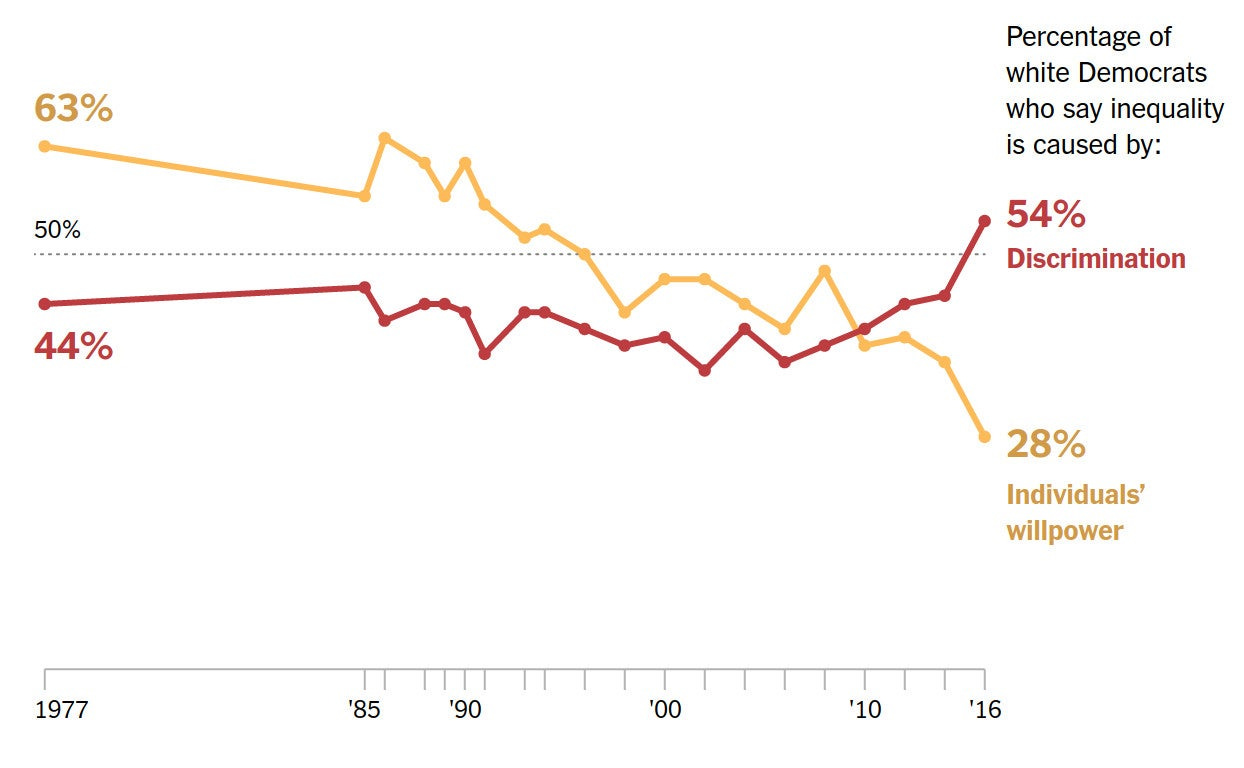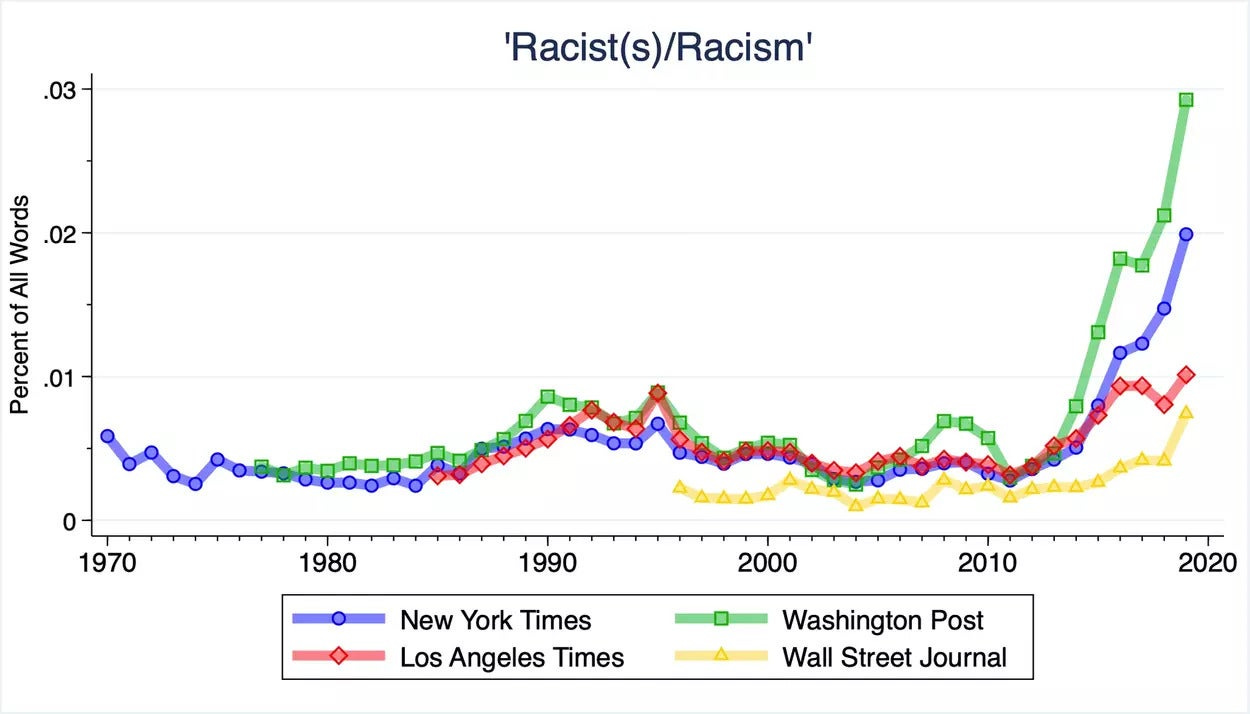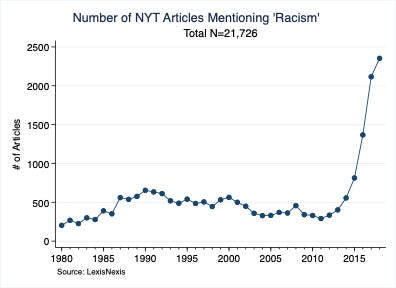Woke Origins: Quantifying Wokeness
The world has changed. I see it in the water.
There seems to be a common perception that, some time in the last couple of years, lots of people on TV and Twitter started acting slightly crazy when discussing race and gender. It’s difficult to deny some sort of major cultural shift has occurred, but on the other hand, this shift isn’t exactly something that necessarily manifests in obvious or disruptive ways on a daily basis. You can take a walk in the bluest of blue cities, as I often do, and fail to note anything particularly different from a typical day in 2009, apart from the people wearing masks and staring at their iPhone 12 Pro Max and Samsung Galaxy S21 phones.
News headlines are filled with controversies over the teaching of Critical Race Theory and Trans-rights activism in entertainment media, along with click-bait about various celebrities, politicians, journalists and Internet personalities getting “cancelled”. Intuitively, these seem like symptoms of a larger cultural shift. But is there any hard data that backs up the intuition that the culture has fundamentally changed in some way, in a relatively short period of time?
(The answer is yes.)
I’m not concerned here with exploring whether or not recent cultural changes are positive or negative (some are positive, but many are counter-productive); I’m merely concerned, in this post, with trying to quantify these changes empirically.
The Etymology of Woke
The driving force of these cultural changes is often colloquially referred to as “wokeness”. This term is often controversial due to its vagueness and association with reactionary media seeking to spread fear over advances in civil rights and progressive politics in general. The term itself has evolved somewhat over the years as well. It began as African American slang that simply referred to a heightened awareness of one’s physical or societal environment, and appears as early as 1938 in a folk/blues song about a group of black teenagers who were accused of raping a white woman. In the 1960s, it had a similar meaning to “hip”, as in “well-informed, up to date”.
Source: New York Times Magazine, May 5, 1962; “Phrases and words you might hear in Harlem or any other Negro community”
“Woke” became more firmly associated with racial justice in 2014 after Ferguson, with the #StayWoke hashtag and the Black Lives Matter movement. An entry for “Stay Woke” also appeared on Urban Dictionary in 2014. The origins of this movement go back significantly further, but it’s around 2014 that the word “woke” entered mainstream pop-culture and rapid cultural changes became increasingly perceptible. At some point, “woke” was co-opted by reactionary elements using the word satirically to mock a perceived racial hyper-sensitivity among progressives. Nowadays, the word is often used as a catch-all adjective to describe the set of cultural changes that have occurred in the latter-half of the 2010s (along with their academic underpinnings), or to describe individuals, movements or ideologies that perpetuate or advocate for such changes. In this post, I use the word “woke” (or “wokeness”, the noun-form) in this latter sense.
Wokeness is, in fact, a quantifiable phenomenon that has resulted in an empirically observable ideological shift in society. Quantifiable evidence for measurable ideological changes in American society is available in the form of multiple avenues of research and polling data that converge to reveal a single, consistent picture: Around 2014 there was a sudden, massive ideological shift among white liberal Democrats towards race consciousness and sensitivity to racial issues.
White Liberal Democrats
This trend is often obscured by countless polls that measure attitudes towards race, but break down survey results by race OR political affiliation, instead of race AND political affiliation. Looking at survey results broken down by either race or political affiliation, you would not necessarily observe a significant change in views about racial justice among white people. But when you observe changes in the views of Democrats, and especially white Democrats (or more broadly, white liberals) in particular, you see a sudden, drastic ideological shift around 2014. This shift also correlates with an exponential increase in the usage of racialized, academic sociological jargon (e.g. "people of color", "whiteness", "marginalized") throughout the news media at around the same time.
Of course, liberal Democrats have always had more progressive views than the average American. However, the opinions of liberal Democrats have mostly been predictable and consistent from the 1970s up until around 2014. But starting in 2014, significant changes rapidly occurred:
There was a large increase in the percentage of white Democrats expressing views reflecting a “racial consciousness”, particularly views that see the economic problems faced by under-privileged minorities as symptoms of societal or systemic oppression
Opinions about race among white Democrats became more progressive than the opinions held by black people on the same issues
More white people began identifying as liberal Democrats
Before 2014, Democrats and Republicans produced predictable polling results when it came to questions such as "Do you believe (A) The country needs to make more changes to give blacks equal rights, or (B) the country has already made the changes needed to give blacks equal rights." From 2009 to 2014, about 60% of Democrats and 30% of Republicans answered (A). Suddenly, between 2014 and 2016, the number shot up to 80% of Democrats. Republicans also saw an increase, but much smaller (up to 36%).
Source: https://www.pewresearch.org/politics/2017/10/05/4-race-immigration-and-discrimination/
That particular poll only goes back to 2009, but we can see that as far back as the 1970s, white Democrats produced predictable polling results when it came to questions like: "Is racial inequality caused by (A) Discrimination or (B) Lack of individual willpower?" From 1977 to 2013, ~44% of white Democrats answered (A). Suddenly, from 2014 to 2016, that number shot up to 54%.
Source: https://www.nytimes.com/2018/05/23/opinion/democrats-race.html
https://nymag.com/intelligencer/2018/02/democrats-are-changing-their-minds-about-race.html
The same trend is observed with the number of Americans who believe racism is a “big problem” in society. From a 2017 Pew Research report:
Two years ago [2015], 50% of the public viewed racism as a major problem for society, and in 2011 just 28% did so. ... Since 2015, the increase in perceptions of racism as a big problem has been almost entirely among Democrats, making an already wide partisan gap in these attitudes even larger.
Once again, we see a sharp increase in the number of Democrats who view racism as a “big problem”, beginning roughly around 2014, and accelerating after 2016.
Source: https://www.pewresearch.org/fact-tank/2017/08/29/views-of-racism-as-a-major-problem-increase-sharply-especially-among-democrats/
Similarly, a 2017 Pew Research poll shows that belief in "white privilege" (or the belief that white people benefit from social advantages that black people do not have) was present among 73% of white Democrats, but only 56% of white people overall. Pew Research did not conduct polls about white privilege prior to 2016, but from 2016 through 2019 we can observe the familiar trend of an increase among white Democrats, along with a somewhat more stable trend among all white people.
Source: Pew Research polls from 2016, 2017, 2018, 2019
It's important to reiterate that the 2014 trend is often obscured by polls that do not break down by race AND political affiliation. For example, this 2015 poll shows that only 45% of whites believe "racism is a problem". In this case, the trend is not visible because the sample included both conservative/Republican and liberal/Democrat whites. Even so, the same poll was conducted again in 2020, showing that the number of whites that believe "racism is a big problem" had increased to 71% (even without breaking down by Democrat/Republican).
It's amazing how consistent the 2014 phenomenon is. It’s observable over a wide range of political polling data concerned with issues of racial awareness or racial justice, as long as the results are broken down by race AND political affiliation. For example, this survey of support for Affirmative Action shows a sudden increase in support among white liberals around 2014.
Again, this survey asking if we should increase spending to improve conditions for black people also shows 2014 as an inflection point.
Again, each group produces predictable, consistent results from 1975 to 2014. Then, in 2014, liberal support increases suddenly and sharply. Moderate and conservative support increases as well, but to a much lesser extent.
You can find some trends that show liberal support for racial justice issues increasing before 2014, such as this survey or this poll, but even here the pre-2014 increase is a slow, linear growth, followed by a rapid acceleration around 2014.
A CNN/ORC poll asked participants whether they "know anyone who is racist". The poll was taken in 2006 and then again in 2015. It doesn't break down by race AND political affiliation, however, it's worth noting that in 2006, 48% of black people overall believed they "knew somebody who was racist", compared with only 35% by 2015. Whereas, with white people overall, we get 43% in 2006 and 50% in 2015. So it seems black people were becoming less worried about racism, whereas whites were becoming more worried about racism.
In some polls the trend is observable even without breaking down the results by political affiliation, such as this Gallup poll demonstrating that anxiety over race relations remained fairly steady from 2001 to 2013, then increased sharply beginning in 2014:
Source: https://news.gallup.com/opinion/gallup/273377/gallup-decade-review-2010-2019.aspx
In parallel with the increasing adoption of racialized views and increasing racial anxiety, the overall number of white liberal Democrats has been increasing as well. By 2018, approximately 40% of all Democrats were white liberals. That same year, the New York Times published a piece discussing this phenomenon. Some select quotes:
Well-educated whites, especially white women, are pushing the [Democratic] party decisively leftward. ... According to Gallup, the share of white Democrats calling themselves liberal on social issues has grown since 2001 from 39 to 61 percent. Because of this growth, white liberals are now roughly 40 percent of all Democratic voters. ... According to Gallup,the leftward shift among Democrats is more pronounced on social issues involving race, gender and sexual identity than it is on economic matters.
Counter-intuitively (or perhaps not), white liberals are sometimes more progressive when it comes to views about race than black people:
Source: https://www.nytimes.com/2018/10/18/opinion/democrat-electorate-left-turn.html
The New York Times also highlighted a 2018 report called "Hidden Tribes", which thoroughly documented the increasing polarization of American society. The Times writes:
The report identified the most liberal constituency as “progressive activists,” a constituency that is expected to make up a quarter of Democratic voters this year. These voters stand apart with “the highest levels of education and socioeconomic status” of all the groups studied. They are “highly sensitive to issues of fairness and equity in society, particularly with regards to race, gender and other minority group identities.” In addition, a third of progressive activists view political correctness as having gone too far, compared with 80 percent of the population as a whole.
Also of interest is the fact that white liberals are the only demographic group in America to display a pro-outgroup bias by indicating a preference for other racial groups over their own in surveys.
Media Trends
These trends are correlated with a similar trend in journalism to more frequently publish content focusing on racism while also adopting CRT terminology. Starting around 2014, the words "racist(s)" and "racism" started to appear much more frequently within the NY Times, Washington Post, LA Times and Wall Street Journal. Again, before 2014, the frequency was more or less predictable, with a brief uptick in the mid 90s (probably due to Rodney King). But that is nothing compared with the exponential increase that begins in 2014. Even the relatively conservative Wall Street Journal begins increasing, probably in reaction to the increase elsewhere.
Source: https://www.tabletmag.com/sections/news/articles/media-great-racial-awakening
A term frequency search using LexisNexis reveals the same trend for NY Times articles containing the word "racism":
We see the same trend for CRT jargon words like "white privilege":
See this Twitter thread for additional charts showing the term frequency in newspaper/media coverage for various CRT jargon phrases (e.g. "diversity and inclusion", "whiteness", "people of color", etc.). Almost every single one is the same hockey-stick graph that takes off around 2014.
Similar to the sharp increase in the word "racist(s)"/"racism" in the NY Times (beginning around 2014), we see the same pattern when looking at CRT jargon frequency in tweets (compiled from https://storywrangling.org):
Hidden Tribes
The "Hidden Tribes" report mentioned earlier classifies Americans across the political spectrum. Some interesting findings about the extreme left (labeled as "Progressive Activists"):
The percent of "Progressive Activist" Americans is slightly larger than the number of far right ("devoted conservative") Americans, at 8% versus 6% respectively
Progressive activists consist of people with the highest levels of political engagement, socio-economic status, and education.
They have an outsized role in political discourse, even though they comprise a small portion of the total population (about 1 in 12 Americans).
They are highly sensitive to issues of fairness and equity in society, particularly with regards to race, gender and other minority group identities.
Compared with the average American, a "Progressive Activist" is:
More likely to list politics as a hobby (73% vs 35%)
More likely to be “ashamed to be an American” (69% vs 24%)
More likely to be white (80% vs 69%)
More likely to have a college degree (59% vs 29%)
Progressive Activists are also more likely than any other group (including far-right conservatives) to feel group pressure to conform to group ideology (42% vs 29%). They are more likely than far-right conservatives to list politics as a hobby (73% vs 63%). And they are more likely than other groups to use social media as a news source (81% vs 62%).
Effect on the Democratic Party
Early indications of mainstream cultural change came from Democratic Primary candidates beginning to campaign using the language of CRT. By 2016, Hillary Clinton regularly made use of CRT terminology in her speeches (including white privilege and systemic racism.)
Ironically, our first black President, Barack Obama, was one of the last mainstream Democrats to speak out AGAINST (or at least attempt to moderate) the increasingly hyper-sensitive racialization appearing in American politics, when he said: "To wish away the resentments of white Americans, to label them as misguided or even racist, without recognizing they are grounded in legitimate concerns, widens the racial divide, and blocks the path to understanding."
Additional Resources
An invaluable resource for documenting these trends is Zach Goldberg, featured in the 2018 NY Times article, who was a doctoral candidate at Georgia State University at the time. He has published articles on tabletmag containing a wealth of research and data documenting the leftward ideological shift. Particularly useful articles include:
How the Media Led the Great Racial Awakening
Additional relevant articles include:
White Americans are finally talking about racism.
Summary
In general, the picture revealed by the data more or less conforms with the intuitive assumption that a large cultural shift has occurred fairly recently and fairly rapidly. Society has undergone a dramatic ideological leftward shift towards "wokeness" (which, to quote Zach Goldberg, can be defined as "[an ideology that] combines the sensibilities of highly educated and hyperliberal white professionals with elements of Black nationalism and academic critical race theory.") This ideological shift occurred around 2014. There were signs of encroaching racialized leftism before 2014, obviously, but somehow it gained critical mass that year, causing a large increase in the percentage of white Democrats expressing increased awareness and sensitivity towards issues of race. Around the same time, publications such as the NY Times and Washington Post began exponentially increasing their journalistic focus on racism.
Can we identify some catalyzing event? 2014 is when the Ferguson riots occurred, so that might have acted as an initial spark. The election of Donald Trump in 2016 surely helped to accelerate the trend as well. But the underlying causes of this are significantly more complex than any single event, and involve a combination of pre-existing trends going back decades, along with social media, and market-forces encouraging the mass production of outrage-inducing click-bait. I will be exploring these trends in detail in future posts. But regardless of the underlying causes, a poll from 2012 versus 2015 will reveal an entirely different ideological landscape among white Democrats.
What about the far-right? In general, extremes on both the left and right end of the political spectrum tend to hold polar opposite views about "flashpoint" social issues like racism and immigration. For example, according to the Hidden Tribes Report, 92% of Progressive Activists believe racism is not taken seriously enough, while 94% percent of far-right Conservatives believe racism is taken too seriously. However, in practice, these two groups do not cancel each other out. Progressive Activists are more numerous and wield significantly more cultural influence in society than far-right Conservatives. Progressive Activists are likely to be rich, white, college-educated, politically active people who populate the ranks of the most prestigious institutions in journalism and academia. In comparison, the cultural influence of far-right Conservatives is often limited to niche media bubbles. However, conservatives often make up for their smaller culture influence via a large political presence in national and state-level elections.
Regardless, the percentage of people actively "driving" this leftward ideological shift is likely small (estimated to be about 8%). But the effect has been very large, causing a broader ideological shift among average white liberals, such that around 40% of Democrats are white liberals who view racial justice as a primary political concern. Moreover, white liberal Democrats are likely to be highly-educated, high-socio-economic-status, politically active people, and thus wield more influence than other cohorts. The sum total of this evidence reflects a significant ideological shift in our society.













